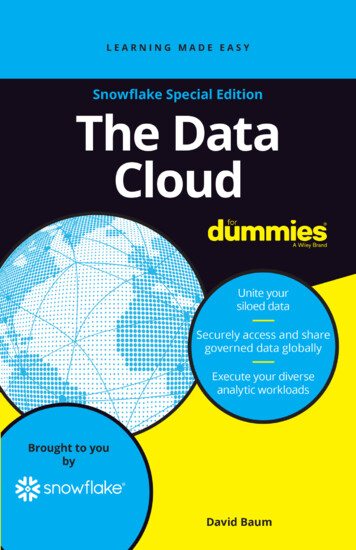
Transcription
These materials are 2021 John Wiley & Sons, Inc. Any dissemination, distribution, or unauthorized use is strictly prohibited.
The DataCloudSnowflake Special Editionby David BaumThese materials are 2021 John Wiley & Sons, Inc. Any dissemination, distribution, or unauthorized use is strictly prohibited.
The Data Cloud For Dummies , Snowflake Special EditionPublished byJohn Wiley & Sons, Inc.111 River St.Hoboken, NJ 07030-5774www.wiley.comCopyright 2021 by John Wiley & Sons, Inc., Hoboken, New JerseyNo part of this publication may be reproduced, stored in a retrieval system or transmitted in any form or by anymeans, electronic, mechanical, photocopying, recording, scanning or otherwise, except as permitted underSections 107 or 108 of the 1976 United States Copyright Act, without the prior written permission of the Publisher.Requests to the Publisher for permission should be addressed to the Permissions Department, John Wiley & Sons,Inc., 111 River Street, Hoboken, NJ 07030, (201) 748-6011, fax (201) 748-6008, or online at http://www.wiley.com/go/permissions.Trademarks: Wiley, For Dummies, the Dummies Man logo, Dummies.com, and related trade dress are trademarksor registered trademarks of John Wiley & Sons, Inc. and/or its affiliates in the United States and other countries,and may not be used without written permission. Snowflake and the Snowflake logo are trademarks or registeredtrademarks of Snowflake Inc. All other trademarks are the property of their respective owners. John Wiley & Sons,Inc., is not associated with any product or vendor mentioned in this book.LIMIT OF LIABILITY/DISCLAIMER OF WARRANTY: THE PUBLISHER AND THE AUTHOR MAKE NO REPRESENTATIONSOR WARRANTIES WITH RESPECT TO THE ACCURACY OR COMPLETENESS OF THE CONTENTS OF THIS WORKAND SPECIFICALLY DISCLAIM ALL WARRANTIES, INCLUDING WITHOUT LIMITATION WARRANTIES OF FITNESSFOR A PARTICULAR PURPOSE. NO WARRANTY MAY BE CREATED OR EXTENDED BY SALES OR PROMOTIONALMATERIALS. THE ADVICE AND STRATEGIES CONTAINED HEREIN MAY NOT BE SUITABLE FOR EVERY SITUATION. THISWORK IS SOLD WITH THE UNDERSTANDING THAT THE PUBLISHER IS NOT ENGAGED IN RENDERING LEGAL,ACCOUNTING, OR OTHER PROFESSIONAL SERVICES. IF PROFESSIONAL ASSISTANCE IS REQUIRED, THE SERVICES OFA COMPETENT PROFESSIONAL PERSON SHOULD BE SOUGHT. NEITHER THE PUBLISHER NOR THE AUTHOR SHALLBE LIABLE FOR DAMAGES ARISING HEREFROM. THE FACT THAT AN ORGANIZATION OR WEBSITE IS REFERRED TOIN THIS WORK AS A CITATION AND/OR A POTENTIAL SOURCE OF FURTHER INFORMATION DOES NOT MEAN THATTHE AUTHOR OR THE PUBLISHER ENDORSES THE INFORMATION THE ORGANIZATION OR WEBSITE MAY PROVIDEOR RECOMMENDATIONS IT MAY MAKE. FURTHER, READERS SHOULD BE AWARE THAT INTERNET WEBSITESLISTED IN THIS WORK MAY HAVE CHANGED OR DISAPPEARED BETWEEN WHEN THIS WORK WAS WRITTEN ANDWHEN IT IS READ.For general information on our other products and services, or how to create a custom For Dummies book for yourbusiness or organization, please contact our Business Development Department in the U.S. at 877-409-4177, contactinfo@dummies.biz, or visit www.wiley.com/go/custompub. For information about licensing the For Dummies brandfor products or services, contact BrandedRights&Licenses@Wiley.com.ISBN 978-1-119-81061-2 (pbk); ISBN 978-1-119-81062-9 (ebk)Manufactured in the United States of America10 9 8 7 6 5 4 3 2 1Publisher’s AcknowledgmentsWe’re proud of this book and of the people who worked on it. Some of thepeople who helped bring this book to market include the following:Development Editor: Brian WallsProject Manager: Martin V. MinnerSenior Managing Editor:Rev MengleAcquisitions Editor: Ashley CoffeyBusiness DevelopmentRepresentative: William HullProduction Editor:Mohammed Zafar AliSnowflake Contributors Team:Vincent Morello, Elise Bergeron,Kent Graziano, Tim Fletcher,Clarke Patterson,Ganesh Subramanian,Christina Jimenez, Leslie SteereThese materials are 2021 John Wiley & Sons, Inc. Any dissemination, distribution, or unauthorized use is strictly prohibited.
Table of ContentsINTRODUCTION. 1Introducing Snowflake’s Data Cloud. 1Icons Used in This Book. 2Beyond the Book. 2CHAPTER 1:Sizing Up Challenges and Opportunitieswith Data. 3Contending with an Immense Volume and Variety of Data. 4Succumbing to Silos — and More Silos. 4Resolving Problems with Fragmented Data. 5Attending to Data Governance. 6Embracing the Cloud. 7Breaking Down the Silos. 8Understanding the Impact of the Data Cloud. 9Sharing Data via a Cloud Network. 10Looking Ahead. 12CHAPTER 2:Understanding the Value and Capabilitiesof the Data Cloud. 13Understanding What You Can Do in the Data Cloud. 13Accessing your data. 14Governing your data. 14Making your data actionable. 14Identifying the Data Cloud’s Unique Attributes. 15Standardizing on one data cloud. 16Supporting all data. 16Powering all workloads. 16Increasing Data Sharing’s Potential. 17Introducing the Snowflake Platform. 18Cloud-built scale and performance. 18Exceptional economic value. 18Inherent ease of use. 19Multi-cloud and cross-cloud flexibility. 19Baked-in security. 20Unique collaboration options. 20Table of ContentsiiiThese materials are 2021 John Wiley & Sons, Inc. Any dissemination, distribution, or unauthorized use is strictly prohibited.
CHAPTER 3:Collaborating in the Data Cloud. 21Understanding the Recursion Rate of Data. 22Introducing a Modern Way to Share Data. 22Looking Beyond the Four Walls of Your Organization. 24Tapping into Snowflake Data Marketplace. 25Differentiating Snowflake Data Marketplace. 27CHAPTER 4:Deploying the Data Cloud Across Industries. 29Yielding Greater Value in Financial Services. 29Delivering Better Healthcare Outcomes. 32Powering the Retail Supply Chain. 34Delivering Superior Media and Entertainment Services. 38Offering Better Public Sector Services. 41CHAPTER 5:Drilling into Snowflake’s Platform. 43Starting with the Right Architecture. 43Building on the Lessons of History. 44Improving performance, lowering costs. 45Understanding why the right architecture matters. 46Establishing One Multi-Region, Multi-Cloud Service. 47Enjoying an Easy-to-Use Platform. 48Predicting and monitoring usage. 48Easing access to all types of data. 49Enforcing Strong Security and Governance. 50CHAPTER 6:Running All Your Workloads. 53Deploying Data Warehouses and Data Lakes. 53Enhancing Core Workloads. 54Executing Other Critical Workloads in the Data Cloud. 55Engineering data pipelines. 55Simplifying data science. 56Creating data applications. 56Sharing Data Without Limits. 58CHAPTER 7:ivSix Steps to Getting Started withthe Data Cloud. 59The Data Cloud For Dummies, Snowflake Special EditionThese materials are 2021 John Wiley & Sons, Inc. Any dissemination, distribution, or unauthorized use is strictly prohibited.
IntroductionInnovators build and transform their businesses with data. To doso, they seek out technology that will enable them to easily andsecurely unify, integrate, analyze, and share that data — withintheir ecosystems and with other organizations keen to do the same.Unfortunately, much of this data is born and remains in silos.Whether on premises or in the cloud, in software applicationsor from customer touchpoints, data becomes fragmented acrossdepartments, data centers, and public clouds. Supply chain operations, point-of-sale transactions, data security apps, and numerous other business processes create unique data stores. This data isdifficult to access, govern, and mobilize in service of your business.Introducing Snowflake’s Data CloudThe Data Cloud is a global network where thousands of organizations mobilize data with near-unlimited scale, concurrency, andperformance. Inside the Data Cloud, organizations can unite theirsiloed data, easily discover and securely share governed data, andexecute diverse analytic workloads. Wherever data or users live,the Data Cloud delivers a unified and seamless experience — evenwhen data and workloads span multiple public clouds. The DataCloud enables discovering, managing, and sharing data amongbusiness units, suppliers, other business partners, and customers.It also provides live access to data and data services from morethan 125 partners in Snowflake Data Marketplace. The opportunities across industries are nearly endless:»» Retailers use the Data Cloud to easily centralize and sharelive data with consumer packaged goods (CPG) companies,supply chains, and other partners, allowing them to optimizepricing, accelerate inventory turns, and increase profits.»» Financial services companies digitize and automateprocesses, reduce fraud and risk exposure, and securelyaccess second- and third-party data and combine it with theirown data to deliver high-value customer services.»» Healthcare providers use the Data Cloud to securely share livehealth data internally and with partners to provide qualitypatient outcomes, reduce costs, and shorten time to market.Introduction1These materials are 2021 John Wiley & Sons, Inc. Any dissemination, distribution, or unauthorized use is strictly prohibited.
»» Media firms centralize subscriber data and share it acrossbrands, advertisers, ad platforms, and enrichment providersto increase subscriber lifetime value, ad revenue, and returnon investment (ROI).»» Manufacturers use the Data Cloud to synchronize supplychain activities across their business ecosystems, increaseplant productivity, and improve production quality whileforging data-driven partner networks.»» Public sector organizations modernize IT and collaborateby securely sharing data across agencies, governments, andpartners for new insights and improved citizen services.Icons Used in This BookThroughout this book, the following icons highlight tips, important points to remember, real-life examples, and more:Advice guiding you on how to use the Data Cloud in yourorganization.Concepts worth remembering as you immerse yourself in understanding the Data Cloud.Case studies about organizations using the Data Cloud to unify,share, and mobilize their data.The jargon beneath the jargon, explained.Beyond the BookIf you like what you read in this book, visit www.snowflake.com toorder a free trial of the Data Cloud, obtain details about plans andpricing, view webinars, access detailed documentation, or get intouch with a member of the Snowflake team.2The Data Cloud For Dummies, Snowflake Special EditionThese materials are 2021 John Wiley & Sons, Inc. Any dissemination, distribution, or unauthorized use is strictly prohibited.
IN THIS CHAPTER»» Understanding data diversity»» Resolving problems with siloed data»» Unifying information in the Data Cloud»» Understanding the potential of a dataecosystemChapter1Sizing Up Challenges andOpportunities with DataNearly every business interaction generates data — whethervia social media, mobile communications, Internet ofThings (IoT) devices, ecommerce transactions, or manytypes of digital services. Multiply those interactions by a growingnumber of connected people, devices, and interaction points, andthe scale is overwhelming — and multiplying every day. As aresult, the business world has a greater need to store and managedata than ever before.The amount of data created, captured, copied, and consumed inthe world from 2010 to 2020 increased from 1.2 trillion gigabytesto 59 trillion gigabytes, according to a recent Forbes report. IDCestimates the amount of data created in the three years from 2020to 2023 will be more than the data created during the previous 30years. Partly in response to this huge influx of new data, the globalcloud computing market size is expected to more than double to 832 billion by 2025, according to MarketsandMarkets research.Yet an Accenture survey of 750 senior business and IT professionals revealed that just 37 percent of the respondents indicatedthey fully achieved the outcomes they expected from leveragingthe cloud. Only 29 percent were completely confident their cloudCHAPTER 1 Sizing Up Challenges and Opportunities with Data3These materials are 2021 John Wiley & Sons, Inc. Any dissemination, distribution, or unauthorized use is strictly prohibited.
migrations would deliver the intended value within the expectedtimeframe. As this chapter shows, a new paradigm is needed toaddress these challenges and opportunities: the Data Cloud.Contending with an ImmenseVolume and Variety of DataIf the immense quantity of data presents business challenges,so, too, does its variety. According to IDC’s “2020 Global DataSphere” report, approximately 80 percent of all new data createdis semi-structured (such as weblog, IoT, and mobile device data)or unstructured (audio, video, PDF, and other types of rich mediacontent). Traditional databases, the backbone of enterprise computing, were not designed to centralize, integrate, analyze, andshare this quantity or diversity of information, either on premisesor in the cloud.These shortcomings have left many business leaders wonderinghow they can participate in the new data economy — the globalsupply, demand, and consumption of data. The need to achieverapid time to value has become more acute, even as the total volume and wide variety of useful data has grown. Unfortunately,most data management and analytics solutions rely on a smallfraction of available data and look backward rather than forward.These systems remain important, but today’s organizations needeasy access to technology, data, and a global network to rapidlydeliver predictive and prescriptive insights that drive operationsforward, best predict and serve customers, and reveal new marketopportunities.One thing is certain: Having a data-centric operation is no longer optional. The opportunities of centralizing your data, andaccessing data and data services in a standardized and seamlessway from thousands of other organizations, is rapidly becomingtoday’s way of achieving success on a scale not possible before.Succumbing to Silos — and More SilosHistorically, technology limitations led IT teams to sequesterdata behind software and network perimeters. Each new datamanagement endeavor created another data silo. Initially, these4The Data Cloud For Dummies, Snowflake Special EditionThese materials are 2021 John Wiley & Sons, Inc. Any dissemination, distribution, or unauthorized use is strictly prohibited.
repositories took the form of data warehouses, supplemented bydata marts, data lakes, and — more recently — a plethora of newtypes of databases designed for machine learning and data science endeavors. As a result, the world’s data is fragmented bydata type, workload, geographic region, and clouds. Many organizations struggle to reconcile these differences, and data living inmany silos is incredibly tough to combine and analyze.Some use cases require data from multiple sources, such as whensemi-structured data in a Hadoop data lake must be combinedwith relational data in one or more data warehouses. To analyze data from these diverse sources, IT professionals may haveto build special-purpose data warehouses that require complexdata-ingestion procedures powered by expensive, proprietaryhardware. Data engineers create custom-coded procedures toextract subsets of the data from each source and merge it into yetanother silo as a means of integrating these data sets.These brittle interfaces must be continuously updated to accommodate new data sources and destinations. For example, datascience apps typically require that data be maintained in a different form (or model) from business intelligence apps. Reconcilingthese differences and keeping all the data in sync requires extensive programming.Most advanced analytics applications and machine learning models leverage unique, individualized data sets because analyzingdata across disparate sources is so difficult.Resolving Problems withFragmented DataImagine if everyone in your organization could access one common repository of consistent, governed data. Think about howeasy it would be to combine all types of data without importing or exporting it from one system to another. What if executives, managers, and operational workers could leverage a singlesource of truth across your entire organization? How much moreproductive would your organization be if your software developers, data scientists, data engineers, and business analysts couldspend more time analyzing data and less time preparing data foranalysis?CHAPTER 1 Sizing Up Challenges and Opportunities with Data5These materials are 2021 John Wiley & Sons, Inc. Any dissemination, distribution, or unauthorized use is strictly prohibited.
These “what ifs” have hung like an albatross around the softwareindustry’s neck for nearly four decades, mainly because of howcorporate information systems store and provide access to data.On premises or in the cloud, each production application maintains data in unique places and formats:»» Marketing data resides in a marketing automation system.»» Sales data is housed in a customer relationship management(CRM) solution.»» Finance data is stored in an enterprise resource planning(ERP) system.»» Inventory data is kept in a warehouse management solution.Extracting production data for analysis creates another set ofsilos: data warehouses for operational reporting, data martsfor departmental analytics, and data lakes for data mining andexploration. These data management systems require specializedextract, transform, and load (ETL) tools to load the data and prepare it for analysis.Many organizations employ highly paid software engineers to setup data pipelines that orchestrate data exchanges among databases and computing platforms. They purchase special-purposeintegration tools to rationalize the differences among data typesand create new destination databases for reporting, analytics, anddata science. The procedures for accessing, combining, and merging data are complex, expensive to maintain, and difficult to scale.Attending to Data GovernanceEven if you follow best practices for storing your data in a datawarehouse or data lake, perennial challenges with security andgovernance are complicated by data privacy regulations that getmore rigorous every year. For example, companies that do business in the European Union must adhere to exacting data lineageand traceability requirements to comply with General Data Protection Regulation (GDPR) requirements. Similar regulations havecome into effect in California with the California Consumer Privacy Act (CCPA). Industry-specific mandates, such as the HealthInsurance Portability and Accountability Act (HIPAA) in healthcare, the Payment Card Industry Data Security Standard (PCI DSS)6The Data Cloud For Dummies, Snowflake Special EditionThese materials are 2021 John Wiley & Sons, Inc. Any dissemination, distribution, or unauthorized use is strictly prohibited.
in ecommerce, and the Sarbanes-Oxley Act (SOX) in finance, further complicate security and governance.Each time you replicate data, you need to apply government andindustry mandates against any new silo. The more data silos youhave, the more complicated compliance becomes because youmust follow the data trail in all its incarnations and instances. Thebest way to integrate these silos is to unify your data in a singlerepository that also provides seamless and performant access toexternal data.Without proper governance, data silos stand in the way of corporate compliance by making it more difficult to trace the data’slineage, catalog the data, and apply security rules. Combiningyour data into a centralized repository simplifies these tasks.Embracing the CloudTo store and share significant amounts of data, many organizations place their data in public cloud repositories, such as AmazonWeb Services (AWS), Microsoft Azure, and Google Cloud Platform(GCP). These ubiquitous services have opened the floodgatesfor storing, sharing, and monetizing data. According to IDC’sSeptember 2020 “Quarterly Cloud IT Infrastructure Tracker,”enterprise cloud spending, both public and private, increased34.4 percent from 2019 to 2020, while non-cloud IT spendingdeclined by 8 percent.As IDC and other researchers point out, although cloud adoptiontrends have increased steadily in recent years, cloud computingand storage practices picked up additional momentum in 2020 inresponse to new work habits formed during the COVID-19 pandemic. Supporting work-from-home employees pushed datastorage and data management activities into overdrive. Applications that facilitate remote communication and data sharingmoved to the forefront as remote work became the norm.Initially, these public cloud services became part of the solutionto the growing number of data silos. However, having abundantcapacity doesn’t necessarily solve the data access problem. Allthat capacity can lead to more confusion and greater disparity dueto various public clouds, inherent incompatibilities among clouds,and different subscription models. Thus, the cloud has engendered a new set of data silos, mainly because you can’t easilyCHAPTER 1 Sizing Up Challenges and Opportunities with Data7These materials are 2021 John Wiley & Sons, Inc. Any dissemination, distribution, or unauthorized use is strictly prohibited.
integrate data and workloads among popular cloud offerings.Although spinning up a cloud database now is easy, that databasecan quickly become its own silo, just as it did in the legacy onpremises world.According to a December 2020 “Cloud Migration Forecast” reportfrom Deloitte, 97 percent of IT managers plan to distribute workloads across two or more clouds to maximize resilience, meetregulatory and compliance requirements, and leverage best-ofbreed services from various providers.Easy availability of these public cloud resources adds to the datadiversity problem because individuals can use a credit card to spinup new cloud instances, often outside of an IT department’s auspices. These departmental databases and information systems arenot always properly deployed, backed up, secured, or integrated,and they may not comply with well-defined IT policies governingthe proper dissemination, protection, and use of data.Hand in hand with the rise of public cloud computing is a vast andgrowing collection of software-as-a-service (SaaS) applications,each with its data formats and repositories. Today, many businesses struggle to reconcile investments in this immense “application cloud,” which can include hundreds or even thousands ofunique apps and data stores at large firms.Public cloud services make it easier to store and access data, butthey also have led to a new set of data silos due to the inherentincompatibilities among the vendor’s clouds. Data assets can’t beeasily shared or moved among them, leading to more replicationof data sets and more data management headaches.Breaking Down the SilosEverybody wants to combine data to form a complete, 360-degreepicture of their constituents — including customers, prospects,citizens, patients, or any other pertinent group they serve. Forexample, marketing professionals commonly record customerinteractions through all available touchpoints, drawing datafrom emails, phone calls, chats, website visits, social mediaposts, point-of-sale transactions, and customer service interactions to gain a complete picture of each customer and prospect.8The Data Cloud For Dummies, Snowflake Special EditionThese materials are 2021 John Wiley & Sons, Inc. Any dissemination, distribution, or unauthorized use is strictly prohibited.
In some cases, the marketing team has collected second- andthird-party data.Achieving these highly prized 360-degree views requires pulling all this data into one place. For example, to determine whichad campaigns generate the best leads, marketers might combine CRM data, call center data, and marketing campaign datato understand each customer’s unique “journey.” Businesses inother sectors face similar challenges, giving rise to such terms as“citizen-360” in government and “patient-360” in healthcare.In all instances, the difficulty amassing and combining dissimilartypes of data presents roadblocks to obtaining complete insights.For example, a healthcare provider might need to combine structured data in a medical records system with unstructured handwritten doctor’s notes and semi-structured image data, such asX-rays and MRIs. In the legal industry, a mass of documentspertaining to lawsuits must be maintained in a form that allowsbroad, free-form search capabilities.Having data in a common repository simplifies segmenting customers and discerning trends, including whom customers contact,which channels they use, which offers interest them, and whichcontent works best for each product, service, and campaign.Whether in healthcare, law, marketing, finance, or any otherdomain, business professionals, data analysts, data engineers, datascientists, and application developers need to confidently access asingle source of truth so their reporting, analytics, and data scienceendeavors yield consistent outcomes. The Data Cloud makes thisexperience possible. You can leverage all your data simultaneously,even when it resides in multiple clouds, without having to importor export data from one system to another. This architecture isa sharp contrast from how data applications were created in thepast: optimized for a specific workload and a single type of data.Understanding the Impactof the Data CloudThe Data Cloud is a global data network that spans multiple public clouds. No matter which cloud services you use, the Data Cloudallows your entire organization to access, analyze, and share thatCHAPTER 1 Sizing Up Challenges and Opportunities with Data9These materials are 2021 John Wiley & Sons, Inc. Any dissemination, distribution, or unauthorized use is strictly prohibited.
data in a secure, seamless, and governed manner, regardless oflocation.Inside the Data Cloud, you can unite siloed data, easily share governed data, and execute various data-driven workloads. Becauseall data is consolidated in one place, you can eliminate the silosand the associated administrative procedures that go along withmaintaining your data.As part of the Data Cloud, your data gains value through association with other data in the Data Cloud ecosystem. For example,the Data Cloud facilitates the process of easily sharing governeddata with partners while leveraging a cohesive set of data services.The Data Cloud meets the needs of businesses in the digital economy by resolving some of the software industry’s most pressingtasks:»» Supporting a wide range of data-driven workloads»» Connecting a diverse set of data sources with a broad set ofdata consumers»» Taking advantage of cost-effective public cloud servicesSharing Data via a Cloud NetworkIn the digital economy, enterprises everywhere need to sharedata. For example, retailers commonly share sales data with vendors to manage inventory and supply chains, and telecommunic
ous other business processes create unique data stores. This data is difficult to access, govern, and mobilize in service of your business. Introducing Snowflake's Data Cloud The Data Cloud is a global network where thousands of organiza-tions mobilize data with near-unlimited scale, concurrency, and performance.











